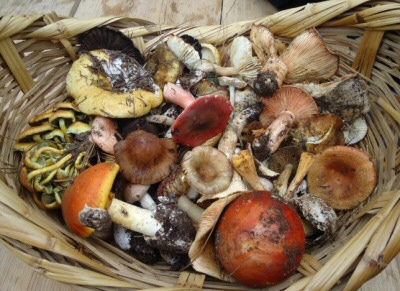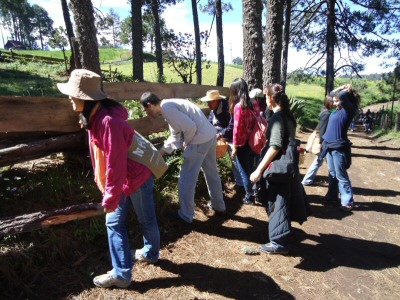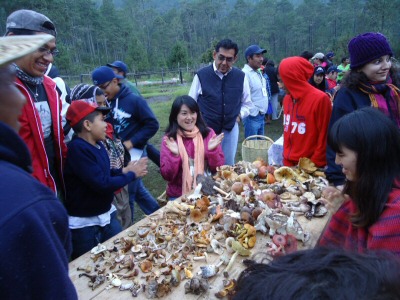
A variety of mushrooms collected by festival attendees
More Photos
|
 A variety of mushrooms collected by festival attendees More Photos
|
More importantly, being part of a group of mushroom and ecotourism aficionados during the Cuahimoloyas annual Feria Regional de Hongos Silvestres makes for a most exciting treasure hunt.
Cuahimoloyas, Mushroom Fair and Ecotourism in Oaxaca's Sierra Norte, Ixtlán District
San Antonio Cuahimoloyas is perched almost 10,500 feet above sea level in the district of Ixtlán. It's one of several pueblos mancomunidados (community managed villages). For hunting mushrooms it can be visited any time of the year, and in fact together with other Ixtlán villages it forms part of a burgeoning ecotourism region in central Oaxaca. While an abundance of species begins to appear at pine trunks in April and May, the broadest diversity of hongos is found beginning June when the amanitas first emerge, and continues through September and well into October.
Hence the 11th annual Oaxacan Feria Regional de Hongos Silvestres was held smack in the middle of prime mushroom hunting season, August 6th and 7th, 2011. During the festival and in fact throughout the entire year, a local guide trained to identify edible, poisonous and hallucinogenic mushrooms must accompany those wanting to trek through the woods, for hiking and other outdoor activities, or for searching out wild mushrooms.
August 6th Hunt for Hongos Silvestres at the Feria Regional, Cuahimoloyas, Oaxaca
Isauro, a lifetime resident of Cuahimoloyas, is our guide / resident mycologist. Our group of nine accompanies him on a four hour trek down into river valleys and up over hills, under cedar fence posts, across fields of light bush and diverse outcrops of brilliant sun-soaked wildflowers, along agave lined dirt roads, and through corn fields.
 Searching for mushrooms More Photos
|
"How many species are there in this area," I ask. "Oh, I suppose we can find 200 or more if we're lucky and we really want to win the contest," he eggs us on.
"Those negritos [little black ones] are edible. They're great marinated in vinegar. But there are other black ones, bigger, hard to find, that we might encounter if we climb up that hill near those tall trees." Isauro picks up a smallish darkened pine cone: "They look like this, and if we find them it'll help us win." Anxiously looking for those rare black mushrooms, my hand reaches just inches away from a piece of cow dung.
Time and again one of us points to a mushroom thinking we've already placed the species in one of three large wicker baskets we're toting. But Isauro shows us a different gilled underside, a bandless stock, or another distinguishing feature. Then a minute later: "That's the same type as this one, except the color is a bit different," or "that hongo looks different because it's already starting to decompose." There a learning curve. My eye catches a large yellow toadstool, half-hidden under pine needles. I approach, then call out. We already have it. But beside my boot there's a much smaller pale green hongo: "Right there, at your foot, we don't have that one," Isauro excitedly exhorts.
"If you squeeze this hongo smoke will come out of a little hole in the top; watch. In unison and in awe, eyes fixated, a long "wow" comes over us. Then moments later, "that one's not really poisonous; it's hallucinogenic, but the one that Silvia is coming to show us is toxic, but not that much." María gingerly places the tiny most delicate hongo we've encountered into a small felt jewelry bag she has by chance brought along.
"This one looks like a big onion. It's great with a little salt and epazote [an aromatic wild herb used in a great deal of Oaxacan cookery]. And this hongo, a trompeta [trumpet], is delicious fried in batter and eaten with rajas [sliced marinated chiles and other vegetable such as carrot and onion pieces]."
 Mushrooms on display More Photos
|
The Return to the Cuahimoloyas Base Camp for the Hongos Silvestres Count, Contests
Almost four hours into our hike, along a potholed dirt road only minutes from the base, we're still miraculously finding mushrooms; under moss, beneath ground hugging agave leaves and emerging from fallen branches. Back at the camp we reunite with the other groups. Each displays its bounty so that the contest judges can determine highest number of mushroom species and best mushroom overall - out of more than 2,000 hongos silvestres collected.
Excitement builds on our team. Isauro disagrees with the judge's determinations from time to time, but consensus is always reached, sometimes in consultation with a colleague mycologist. Another group's hongo total was 207. Must be the winner I figure. Counting continues; 208, 209, 225, upward and onward. We weigh in at 254. The chatter begins, from even local experts. Can Isauro's team possibly be topped? One last group's total has yet to be tallied; 237, 238, and finally 239. Our team cheers aloud.
At the awards ceremony we take prize for most species. In the best single mushroom category the prize goes not to a spectacular, perfect Amanita muscaria specimen, but to a much smaller yet rarer mushroom with excellent flavor, a Morchella esculenta - or was it the Fr. y M. elata; in either case it was a morel.
It's approaching 7 p.m. We're off to the cabins to turn in, since tomorrow brings another full day of wild mushrooms; not another hunt, but rather different activities at the weekend Feria Regional de Hongos Silvestres in Cuahimoloyas, Oaxaca, Mexico.
Two days in the midst of Oaxaca's rainy season, yet without a drop. It's almost as if the fair organizers knew which weekend to choose - perhaps someone had a mushroom induced vision.
Alvin Starkman is a paid contributing writer for Mexico Today, a program for Marca País - Imagen de México. Alvin enjoys taking visitors to Oaxaca to explore more off the beaten track sights, and encourages them to enjoy a diversity of experiences in addition to "the usual." Alvin has written over 200 articles about life and cultural traditions in Oaxaca, consults to documentary film companies, and with his wife operates Casa Machaya Oaxaca Bed & Breakfast